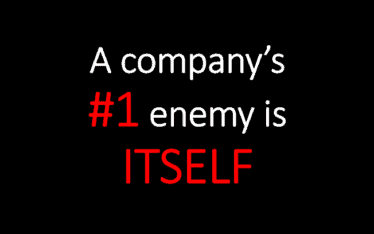The culture of an organization is practically its DNA
An organization’s culture is deeply embedded in the system and is therefore extremely difficult to change.
Changing an organization’s culture is one of the most difficult leadership challenges. That’s because an organization’s culture comprises an interlocking set of goals, roles, processes, values, communications practices, attitudes and assumptions.
But what is organizational culture?
Why is organizational culture change difficult
Here are some reasons why:
- The culture of an organization is practically its DNA. Culture determines how everything else in the organization unfolds. As Peter Drucker said: “Culture eats strategy for breakfast”
- The organization and its culture are reciprocal and interdependent: the organization, its design and strategies influence its overall culture and vice versa
- An organization’s culture reflects its deepest values and beliefs. Trying to change it can call into question everything the organization holds dear, often without that conscious intention
- The culture of an organization is embedded in the entire organizational system. Each little change effects every layer of that system
- Organizational culture evolves over time. An organization’s identity is based on its culture, which is deeply linked to its history and development
Changing culture is a bit like changing the course of a large ship – it takes time to man oeuvre and whilst the engines are pushing one way the tides and winds are pushing another
In sum, the culture of an organization creates its unique, complex face and character. As such, it is as difficult to change in its entirety as the whole personality of a human being or that of a nation.
Changing a culture is a large-scale undertaking, and eventually all of the organizational tools for changing minds will need to be put in play. Let’s not forget that organizational culture is like an iceberg with most of its weight and bulk below the surface.
Short URL & title:
Why is organizational culture change difficult — https://www.torbenrick.eu/t/r/qna
Share it:
If you enjoyed this article, please take 5 seconds to share it on your social network. Thanks!









Thank you for the insight on this subject your article really helped me a lot i’ve been having problems with my company and we are thinking what to do, what direction to turn i think you’ve given me some inspiration.
On the performance engineering side, change is a cost, not a benefit. Until there is an expectation of value that exceeds the expectation of cost, change will be resisted.
Most of the change problems I have witnessed come from a failure to manage the change.
Where change is a value, it can be assigned using the usual tools that include identification and commitment of appropriate resources, and responsibility/accountability for accomplishment by those who implement. The one who has authority to assign is also the one who assumes responsibility for exception management under the rule: “If it is important enough to assign, it is important enough to manage.”
Change is personal. When we find a partner in life, we are constantly told by others – ‘don’t let them change you!’ We are told in the media, ‘stay true to yourself’, ‘don’t let anybody change you’. As children we are told by our parents, ‘don’t let others influence you, be yourself’, we tell our children the same messages. Change is something we are not taught to embrace, we were not taught to understand what ‘healthy’ change looks like. Change is feared.
So how can we expect employees to switch off these innate paradigms and change. Acknowledging that change is personal, that each individual will have different anxieties and therefore reactions (whether you agree with them or not), is the first step.
How can change be managed if the manager doesn’t understand ‘change’ themselves. It is the blind leading the blind. The info graph provided is a great start.
Torben, Great article and very accurate descriptions of what a culture is and why it is so hard to change. Thanks.
Thanks David
Torben,
I have to disagree that culture change is difficult. You can never change the entire culture of any organization unless you fire everyone. You can shape the experiences that change beliefs that motivate action to achieve results, but this is all about shifting the way people think and behave. Again, leaders need to understand this is not difficult, it all starts with defined and clarified results, then determine what experiences are needed to change the beliefs that will motivate the actions to obtain those results. Yes, its this easy. Send me your email. I will send the steps in how this done. Cheers.
Torben,
I disagree with Russell. Sometimes you do have to replace a certain number of key people but my experience is you can also change culture by modelling and reinforcing what you want.
At the same time you need to send clear and consistent messages around empowering the relevant dimensions of individuals. For example, I get really annoyed when companies create groups such as “innovation groups” which automatically excludes and disempowers outsiders. A better solution is to recognise and encourage innovation conversations and behaviours across the business.
All that said. I’d be interested in your understanding of “character” which seems to be an alternative to “culture” as a focus for some companies.
Such a brilliant article, love the rich metaphors! Thank you Torben!
Great sharing and you have highlighted the truth of what is happening in most organizations. Driving cultural change should be done from the top, and with clear intent and purpose and having this shared with all employees. Walking the talk, treating individual employee with respect and trust will certainly help in this. Very often with unclear roles and responsibilities as well as lack of empowerment will make this change even tougher and near impossible.
There are six ways to assure your culture is ‘strategy-ready’ for the coming evolution:
Model change comfort. Be a model for others and encourage your leadership team to develop a realistic and comfortable view of change. An attitude of ‘change is part of being in business’ is realistic and calm. Consider the leader who, faced with a new competitor who was making inroads, fumed and insisted they were idiots and wouldn’t last. His denial set a tone. His salespeople decided it was ok to ‘leave well enough alone’ and not provide street intelligence about the competitor’s approach. It is equally important not to be seen as a change junkie. Change is fatiguing, and your staff need to feel that your strategies for change are necessary and worth their discomfort.
Indulge risk. The negative connotations of risk always outweigh the positive – and should be given due diligence. But without risk there is no opportunity. Creating an atmosphere of exploration of risks opens healthy debate in the organization.
Ray Bradbury said, “Living at risk is jumping off the cliff and building your wings on the way down.” The most strategy-ready organizations have an expectation of building wings on the way down.
Keep the vision front and center. Articulate, then repeat, repeat, repeat the story of where you are going and why it’s important. People in an organization are acculturated to anchor themselves in the mission of the organization, but that is a symbol of the steady state. They need to continually be re-anchored in the ‘both-and’ paradigm of mission and vision: steady mission and evolving vision – things will change and we’ll still remain true to who we are.
Establish a history of successful change. Pay attention to not just the completion of your strategies, but how they are completed. Ask for lessons learned, and assure they are used in subsequent change implementations. Express public appreciation for additions to the history bank of successful change.
Build change support systems. The more predictable the path, the easier to walk it. Having a predictable change management approach and resources build confidence that the coming series of changes can be handled. One of the biggest barriers to successful change is feeling like you don’t know how to do it. Building expertise in a change management process and providing strong resources like organizational design support and communications expertise and feedback mechanisms goes a long way to making big change less overwhelming.
Create an environment of openness to candor. People will more willingly accept new ideas if they can expect two things: empathy with their emotional state as it evolves over time, and an invitation to offer candid, respectful input and feedback. Building these into a culture takes perseverance. Natural tendencies are to simplify the messiness of change by excluding from consideration those things that could create additional chaos. But the truth is, the chaos will hit anyway – and not in a planned and rational way. Institutionalizing empathy and invitation will help to assure the dead cats are delivered to your doorstep when you can still bury them.
Before you serve up your strategy, take a look at the culture that will eat it. How easily will it be digested? Maybe you would benefit from an additional strategy – one to build ‘strategy-readiness’.